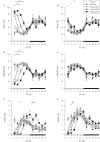Central deficiency of corticotropin-releasing hormone receptor type 1 (CRH-R1) abolishes effects of CRH on NREM but not on REM sleep in mice
- PMID: 20394311
- PMCID: PMC2849781
- DOI: 10.1093/sleep/33.4.427
Central deficiency of corticotropin-releasing hormone receptor type 1 (CRH-R1) abolishes effects of CRH on NREM but not on REM sleep in mice
Abstract
Study objectives: Corticotropin-releasing hormone (CRH) is the major activator of the hypothalamic-pituitary-adrenocortical (HPA) system and orchestrates the neuroendocrine, autonomous as well as behavioral responses to stress. Many studies suggest an influence of CRH on sleep-wake regulation even in the absence of stressors. However, none of these studies yet clearly distinguished between central and peripheral effects of CRH. Therefore, we investigated in CNS-specific CRH receptor type 1 deficient mice whether centrally administered CRH could induce its sleep-wake modulatory effects without peripheral induction of HPA activity.
Design: Male mice (C57BL/6J, CNS-specific CRH-R1 knockout [CKO] mice and their control littermates [CL]) were intracerebroventricularily (i.c.v.) injected with vehicle or 3 different doses of CRH shortly before the beginning of the light period. Electroencephalogram (EEG) and electromyogram (EMG) were monitored to compare the effects of CRH on vigilance states with or without presence of central CRH-R1. To quantify HPA-axis reactivity to CRH injections in CKO and CL animals, blood samples were analyzed to determine plasma corticosterone concentrations.
Results: I.c.v. injections of CRH promoted wakefulness while decreasing NREMS in C57BL/6J and CRH-R1 CL animals, whereas such changes were not exerted in CKO mice. However, REMS suppression after CRH application persisted in all animals. I.c.v. injected CRH increased plasma corticosterone levels in both CL and CKO mice.
Conclusions: The results demonstrated that CRH has a major impact on wake and NREMS regulation which is predominantly mediated through central CRH-R1. Peripheral actions of CRH, i.e., elevated HPA activity, may interfere with its central effects on REMS but not on NREMS suppression.
Figures

 1.0μg, •: 3.0 μg). The hatched area indicates mean values ± SEM after vehicle treatment. The symbols +,*, and # denote statistically significant differences by comparison of vehicle versus treatment with 0.3, 1.0, or 3.0 μg of CRH, respectively (tests with contrasts in ANOVA, P < 0.05). Solid lines under those symbols connect consecutive time points showing statistical differences. The open and filled bar on the x-axis indicates the light and dark period, respectively.
1.0μg, •: 3.0 μg). The hatched area indicates mean values ± SEM after vehicle treatment. The symbols +,*, and # denote statistically significant differences by comparison of vehicle versus treatment with 0.3, 1.0, or 3.0 μg of CRH, respectively (tests with contrasts in ANOVA, P < 0.05). Solid lines under those symbols connect consecutive time points showing statistical differences. The open and filled bar on the x-axis indicates the light and dark period, respectively.


Similar articles
-
Deficiency of corticotropin-releasing hormone type-2 receptor alters sleep responses to bacterial lipopolysaccharide in mice.Brain Behav Immun. 2011 Nov;25(8):1626-36. doi: 10.1016/j.bbi.2011.06.008. Epub 2011 Jun 17. Brain Behav Immun. 2011. PMID: 21704697
-
Conditional corticotropin-releasing hormone overexpression in the mouse forebrain enhances rapid eye movement sleep.Mol Psychiatry. 2010 Feb;15(2):154-65. doi: 10.1038/mp.2009.46. Epub 2009 May 19. Mol Psychiatry. 2010. PMID: 19455148 Free PMC article.
-
Growth hormone-releasing hormone and corticotropin-releasing hormone enhance non-rapid-eye-movement sleep after sleep deprivation.Am J Physiol Endocrinol Metab. 2006 Sep;291(3):E549-56. doi: 10.1152/ajpendo.00641.2005. Am J Physiol Endocrinol Metab. 2006. PMID: 16912060 Clinical Trial.
-
Sleep and the hypothalamo-pituitary-adrenocortical system.Sleep Med Rev. 2002 Apr;6(2):125-38. doi: 10.1053/smrv.2001.0159. Sleep Med Rev. 2002. PMID: 12531148 Review.
-
Neurochemical regulation of sleep.J Psychiatr Res. 2007 Oct;41(7):537-52. doi: 10.1016/j.jpsychires.2006.04.007. Epub 2006 Jun 13. J Psychiatr Res. 2007. PMID: 16777143 Review.
Cited by
-
Role of corticosterone on sleep homeostasis induced by REM sleep deprivation in rats.PLoS One. 2013 May 7;8(5):e63520. doi: 10.1371/journal.pone.0063520. Print 2013. PLoS One. 2013. PMID: 23667630 Free PMC article.
-
Restoring Serotonergic Homeostasis in the Lateral Hypothalamus Rescues Sleep Disturbances Induced by Early-Life Obesity.J Neurosci. 2018 Jan 10;38(2):441-451. doi: 10.1523/JNEUROSCI.1333-17.2017. Epub 2017 Dec 1. J Neurosci. 2018. PMID: 29196316 Free PMC article.
-
Brain-specific inactivation of the Crhr1 gene inhibits post-dependent and stress-induced alcohol intake, but does not affect relapse-like drinking.Neuropsychopharmacology. 2012 Mar;37(4):1047-56. doi: 10.1038/npp.2011.297. Epub 2011 Nov 23. Neuropsychopharmacology. 2012. PMID: 22113086 Free PMC article.
-
Mammalian sleep genetics.Neurogenetics. 2012 Nov;13(4):287-326. doi: 10.1007/s10048-012-0341-x. Epub 2012 Sep 14. Neurogenetics. 2012. PMID: 22976546 Review.
-
Nesfatin-1/NUCB2 as a potential new element of sleep regulation in rats.PLoS One. 2013;8(4):e59809. doi: 10.1371/journal.pone.0059809. Epub 2013 Apr 1. PLoS One. 2013. PMID: 23560056 Free PMC article.
References
-
- Vale W, Spiess J, Rivier C, Rivier J. Characterisation of a 41-residue ovine hypothalamic peptide that stimulates secretion of corticotropin and β-endorphin. Science. 1981;213:1394–7. - PubMed
-
- Müller MB, Wurst W. Getting closer to affective disorders: the role of CRH receptor systems. Trends Mol Med. 2004;10:409–15. - PubMed
-
- Bale TL, Vale WW. CRF and CRF receptors: Role in stress responsivity and other behaviors. Annu Rev Pharmacol Toxicol. 2004;44:525–57. - PubMed
-
- Dunn AJ, Berridge CW. Physiological and behavioural responses to corticotropin-releasing factor administration: is CRF a mediator of anxiety or stress responses? Brain Res Rev. 1990;15:71–100. - PubMed
-
- Opp MR. Rat strain differences suggest a role for corticotropin-releasing hormone in modulating sleep. Physiol Behav. 1998;63:67–74. - PubMed
Publication types
MeSH terms
Substances
LinkOut - more resources
Full Text Sources
Molecular Biology Databases

